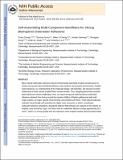| dc.contributor.author | Zhong, Chao | |
| dc.contributor.author | Gurry, Thomas | |
| dc.contributor.author | Cheng, Allen A. | |
| dc.contributor.author | Downey, Jordan | |
| dc.contributor.author | Deng, Zhengtao | |
| dc.contributor.author | Stultz, Collin M. | |
| dc.contributor.author | Lu, Timothy K. | |
| dc.date.accessioned | 2016-01-14T16:44:34Z | |
| dc.date.available | 2016-01-14T16:44:34Z | |
| dc.date.issued | 2014-09 | |
| dc.date.submitted | 2013-10 | |
| dc.identifier.issn | 1748-3387 | |
| dc.identifier.issn | 1748-3395 | |
| dc.identifier.uri | http://hdl.handle.net/1721.1/100833 | |
| dc.description.abstract | Many natural underwater adhesives harness hierarchically assembled amyloid nanostructures to achieve strong and robust interfacial adhesion under dynamic and turbulent environments. Despite recent advances, our understanding of the molecular design, self-assembly and structure–function relationships of these natural amyloid fibres remains limited. Thus, designing biomimetic amyloid-based adhesives remains challenging. Here, we report strong and multi-functional underwater adhesives obtained from fusing mussel foot proteins (Mfps) of Mytilus galloprovincialis with CsgA proteins, the major subunit of Escherichia coli amyloid curli fibres. These hybrid molecular materials hierarchically self-assemble into higher-order structures, in which, according to molecular dynamics simulations, disordered adhesive Mfp domains are exposed on the exterior of amyloid cores formed by CsgA. Our fibres have an underwater adhesion energy approaching 20.9 mJ m[superscript −2], which is 1.5 times greater than the maximum of bio-inspired and bio-derived protein-based underwater adhesives reported thus far. Moreover, they outperform Mfps or curli fibres taken on their own and exhibit better tolerance to auto-oxidation than Mfps at pH ≥ 7.0. | en_US |
| dc.description.sponsorship | United States. Office of Naval Research (N000141310647) | en_US |
| dc.description.sponsorship | National Science Foundation (U.S.). Materials Research Science and Engineering Centers (Program) (Award DMR-0819762) | en_US |
| dc.description.sponsorship | National Institutes of Health (U.S.) (New Innovator Award 1DP2OD008435) | en_US |
| dc.language.iso | en_US | |
| dc.publisher | Nature Publishing Group | en_US |
| dc.relation.isversionof | http://dx.doi.org/10.1038/nnano.2014.199 | en_US |
| dc.rights | Creative Commons Attribution-Noncommercial-Share Alike | en_US |
| dc.rights.uri | http://creativecommons.org/licenses/by-nc-sa/4.0/ | en_US |
| dc.source | PMC | en_US |
| dc.title | Self-assembling multi-component nanofibres for strong bioinspired underwater adhesives | en_US |
| dc.title.alternative | Strong underwater adhesives made by self-assembling multi-protein nanofibres | en_US |
| dc.type | Article | en_US |
| dc.identifier.citation | Zhong, Chao, Thomas Gurry, Allen A. Cheng, Jordan Downey, Zhengtao Deng, Collin M. Stultz, and Timothy K. Lu. “Strong Underwater Adhesives Made by Self-Assembling Multi-Protein Nanofibres.” Nature Nanotechnology 9, no. 10 (September 21, 2014): 858–866. | en_US |
| dc.contributor.department | Institute for Medical Engineering and Science | en_US |
| dc.contributor.department | Massachusetts Institute of Technology. Computational and Systems Biology Program | en_US |
| dc.contributor.department | Massachusetts Institute of Technology. Department of Biological Engineering | en_US |
| dc.contributor.department | Massachusetts Institute of Technology. Department of Electrical Engineering and Computer Science | en_US |
| dc.contributor.department | Massachusetts Institute of Technology. Research Laboratory of Electronics | en_US |
| dc.contributor.department | Massachusetts Institute of Technology. Synthetic Biology Center | en_US |
| dc.contributor.mitauthor | Zhong, Chao | en_US |
| dc.contributor.mitauthor | Gurry, Thomas | en_US |
| dc.contributor.mitauthor | Cheng, Allen A. | en_US |
| dc.contributor.mitauthor | Deng, Zhengtao | en_US |
| dc.contributor.mitauthor | Stultz, Collin M. | en_US |
| dc.contributor.mitauthor | Lu, Timothy K. | en_US |
| dc.contributor.mitauthor | Downey, Jordan | en_US |
| dc.relation.journal | Nature Nanotechnology | en_US |
| dc.eprint.version | Author's final manuscript | en_US |
| dc.type.uri | http://purl.org/eprint/type/JournalArticle | en_US |
| eprint.status | http://purl.org/eprint/status/PeerReviewed | en_US |
| dspace.orderedauthors | Zhong, Chao; Gurry, Thomas; Cheng, Allen A.; Downey, Jordan; Deng, Zhengtao; Stultz, Collin M.; Lu, Timothy K. | en_US |
| dc.identifier.orcid | https://orcid.org/0000-0002-3415-242X | |
| dc.identifier.orcid | https://orcid.org/0000-0002-9999-6690 | |
| dc.identifier.orcid | https://orcid.org/0000-0002-8639-1860 | |
| dc.identifier.orcid | https://orcid.org/0000-0002-8428-8982 | |
| mit.license | OPEN_ACCESS_POLICY | en_US |
